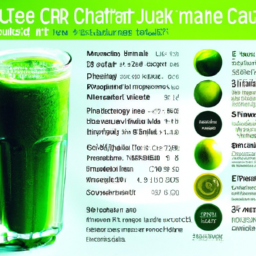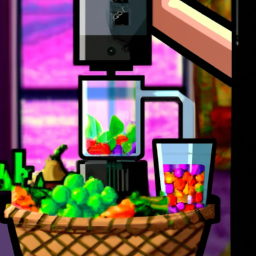In order to take care of my health and wellness, I understand the importance of being conscious of the calorie content in the food and drinks I consume. This is especially important when it comes to green juice, a popular choice for those looking to incorporate more fruits and vegetables into their diet.
Knowing how many calories are in a green juice can help me make informed decisions about my daily food intake and ensure that I am meeting my nutritional goals.
In this article, I will explore the calorie content of green juice and provide tips for measuring and calculating the calorie count of your favorite recipe. I will also examine the factors that can affect the calorie count of green juice and offer suggestions for balancing nutritional value with calorie count.
Whether you are a seasoned green juice drinker or just starting out, this article will provide you with the information you need to make the most of this healthy beverage.
Key Takeaways
- Understanding the calorie content of green juice is important for tracking daily intake and achieving weight loss goals.
- Measuring ingredients accurately and understanding the nutritional profile of substitutes is crucial for maintaining nutrient density and calorie count balance in green juice.
- Green juice should not be relied on as a meal replacement, and portion control is important.
- Pairing green juice with other nutrient-dense foods and adding healthy fats, superfoods, and protein/fiber sources can enhance the health benefits of incorporating green juice into the daily diet.
Importance of Counting Calories in a Healthy Diet
You know that counting calories is crucial when it comes to maintaining a healthy diet, so it’s important to keep track of the calories in that green juice you’re sipping on.
Tracking progress and practicing mindful eating are essential in achieving your health goals. By monitoring your calorie intake, you can ensure that you’re not consuming more than your body needs, and you can adjust accordingly to achieve your desired weight.
Mindful eating involves being aware of what you’re putting into your body and how it affects your overall health. It means paying attention to the nutritional value of the food and drinks you consume, and being conscious of the amount of calories you’re taking in.
Understanding the calorie content of popular green juice ingredients is an important part of mindful eating, so let’s dive into it.
Understanding the Calorie Content of Popular Green Juice Ingredients
As I’m exploring the importance of calorie counting in a healthy diet, I want to delve deeper into the calorie content of popular green juice ingredients.
Leafy greens, such as kale and spinach, are low in calories and high in nutrients. They make a great addition to any juice blend.
Fruits, like apples and berries, can add natural sweetness to a juice while also providing essential vitamins and fiber.
Vegetables, herbs, and spices can also be incorporated into green juice blends to provide added flavor and health benefits.
Leafy Greens
Eating leafy greens in a green juice is like injecting a dose of pure energy into your body. Not only are they low in calories, but they are also packed with an array of nutrients that are essential for optimum health. Some of the most popular leafy greens used in green juice recipes include spinach, kale, and collard greens.
Juicing techniques can extract the maximum amount of nutrients from these greens, making them a highly nutritious addition to your diet. For instance, spinach is high in vitamin A, which is essential for maintaining good eyesight, while kale is a great source of vitamin K, which plays a crucial role in blood clotting. Here is a table highlighting the nutritional benefits of some popular leafy greens:
| Leafy Green | Nutritional Benefits |
|---|---|
| Spinach | High in Vitamin A, Iron, and Calcium |
| Kale | High in Vitamin K, Vitamin C, and Fiber |
| Collard Greens | High in Vitamin A, Vitamin C, and Calcium |
Moving on to fruits, they are an essential component of green juices as they not only add sweetness but also provide a variety of vitamins and minerals.
Fruits
Adding fruits to your green juice not only enhances the taste but also provides a range of essential vitamins and minerals to fuel your body. Juicing techniques vary, but some popular fruits to add to your green juice include apples, pears, pineapples, and oranges.
Here are three health benefits of adding fruits to your green juice:
-
Increased fiber intake: Fruits are a great source of fiber, which is important for maintaining a healthy digestive system and keeping you feeling full.
-
Boosted immune system: Fruits like oranges and pineapples are high in vitamin C, which is essential for a strong immune system.
-
Improved skin health: Fruits like apples contain antioxidants that can help protect your skin from damage caused by harmful environmental factors.
When it comes to green juice, fruits are an important ingredient to consider. However, it’s also important to remember the benefits of adding leafy greens to your juice. Vegetables like kale and spinach are loaded with nutrients and can provide a range of health benefits.
Vegetables
Well, look who’s decided to join the veggie party! You might be surprised to know that incorporating vegetables into your juicing routine can actually be quite delicious.
Juicing techniques have come a long way, and now there are many recipes that incorporate vegetables in a tasty way. From kale to spinach to cucumber, there are endless possibilities for creating a nutrient-dense green juice.
Not only are green juices delicious, but they also provide numerous nutritional benefits. Vegetables are packed with vitamins, minerals, and antioxidants that can help boost your immune system, improve digestion, and reduce inflammation. Adding vegetables to your juice can help you reach your daily recommended intake of these essential nutrients.
So, don’t be afraid to experiment with different vegetables and find the ones that work best for you. Speaking of experimentation, have you ever considered adding herbs and spices to your green juice? By doing so, you can enhance the flavor and add even more nutritional benefits.
Let’s dive into the world of herbs and spices and see what they can do for your juicing routine.
Herbs and Spices
Let’s spice things up and explore how herbs can take your juice game to the next level! Adding herbs and spices to your green juice not only enhances the flavor but also provides several health benefits.
Here are some of the benefits of herbs and spices in green juice:
- Boosts immune system: Herbs like ginger, turmeric, and garlic have anti-inflammatory properties that help boost the immune system.
- Aids digestion: Mint, fennel, and ginger help soothe the stomach and aid in digestion, reducing bloating and indigestion.
- Lowers blood sugar: Cinnamon and fenugreek have been found to lower blood sugar levels, making them great additions to a low-calorie green juice.
When it comes to the best herbs and spices for a low-calorie green juice, the options are endless. Some of my personal favorites include ginger, mint, cilantro, and basil. These herbs not only add a refreshing taste but also provide numerous health benefits.
Now that we know the benefits and best herbs to use, let’s move on to the next step: tips for measuring ingredients.
Tips for Measuring Ingredients
Honestly, if you’re not measuring your ingredients for your green juice, you might as well just drink a milkshake. When it comes to making a green juice, measuring accuracy is crucial. Even a small deviation in the amount of an ingredient can dramatically alter the taste and nutritional value of your juice.
For instance, if you add too much ginger, your juice might become too spicy, or if you add too much kale, your juice might become too bitter. Moreover, if you’re trying to substitute an ingredient in your green juice, it’s essential to measure the substitute accurately. Otherwise, you might end up with an unpalatable juice or one that lacks the nutritional benefits you’re after.
To ensure measuring accuracy, use a kitchen scale to weigh your ingredients, or use measuring cups and spoons. Don’t eyeball the amounts, as it’s easy to over or underestimate your measurements. Additionally, keep your ingredients organized and accessible to avoid confusion and mistakes.
If you’re substituting an ingredient, make sure you understand the nutritional profile of the substitute and adjust the amount accordingly. By measuring your ingredients accurately, you’ll be able to create a delicious and nutrient-dense green juice that meets your goals and preferences.
Now that you know how to measure your ingredients accurately, let’s move on to calculating the calorie count of your green juice. By knowing the calorie content of your juice, you can track your daily calorie intake and adjust your diet accordingly. In the next section, we’ll explore how to calculate the calorie count of your green juice using simple formulas.
Calculating the Calorie Count of Your Green Juice
Now that we know how to measure ingredients accurately, let’s dive into the calorie count of green juice. As someone who practices juice fasting and juicing for weight loss, it’s important to understand the nutritional value of what I consume.
Calculating the calorie count of your green juice is vital in achieving your health goals. Green juice typically contains a variety of vegetables and fruits, making it a nutrient-dense drink. However, it’s essential to note that the calorie count varies based on the ingredients used in the recipe.
For instance, a green juice made with kale, cucumber, and apple will have a different calorie count than one made with spinach, celery, and lemon. Knowing the calorie count of your green juice is crucial in maintaining a balanced diet and achieving your desired weight loss goals.
Moving forward, let’s explore some common green juice recipes and their calorie content.
Common Green Juice Recipes and Their Calorie Content
You can easily determine the nutritional value of your favorite green juice recipes by checking their calorie content, which may surprise you and motivate you to make healthier choices. Variations of green juice recipes can affect their calorie count, with some recipes containing more fruits and sweeteners than others.
For example, a green juice made with mostly vegetables and a small amount of fruit will have a lower calorie count than one made with mostly fruit and sweeteners. Another factor to consider is whether you make your green juice at home or purchase it from a store.
Homemade green juice allows you to control the ingredients and portion sizes, which can result in a lower calorie count. Store-bought green juice, on the other hand, may contain added sugars and preservatives that increase its calorie count. By being mindful of the ingredients and preparation methods, you can make healthier choices and enjoy the benefits of green juice.
In the next section, we will explore the factors that affect calorie count in more detail.
Factors That Affect Calorie Count
When it comes to keeping your body healthy, it’s important to understand how different factors can affect the calorie count of your green juice.
One of the most significant factors is the juice extraction method. Different juicing techniques, such as cold-pressed or centrifugal, can result in varying degrees of pulp, which affects the calorie count. For instance, a juice with more pulp will have a higher calorie count since the pulp contains fiber and other nutrients.
In addition to juice extraction, the ingredients used in the green juice also impact its calorie count. Fruits, for example, contain more calories than vegetables due to their higher sugar content. Therefore, a green juice with more fruit will have a higher calorie count than one with more vegetables.
It’s essential to note that while fruits and vegetables add nutritional value to the juice, they also add calories. Thus, it’s crucial to balance the nutritional value and calorie count of your green juice.
Balancing Nutritional Value and Calorie Count
Finding the perfect balance between the nutrient density and calorie count of your green juice is essential for achieving a healthy lifestyle. While it’s important to consider calorie intake, it’s equally important to ensure that your green juice is packed with essential vitamins, minerals, and antioxidants.
Here are four ways to balance nutritional value and calorie count in your green juice:
- Use a variety of fruits and vegetables to increase nutrient density while keeping calorie count low.
- Incorporate healthy fats such as avocado or chia seeds to increase satiety and promote healthy hydration.
- Avoid adding sweeteners such as honey or maple syrup, which can increase calorie intake without providing significant nutritional value.
- Consider adding superfoods such as spirulina or wheatgrass to boost nutritional content without adding substantial calories.
By following these guidelines, you can enjoy a delicious and nutritious green juice without compromising your calorie intake.
Incorporating green juice into your daily diet can provide numerous health benefits, including improved digestion, increased energy levels, and enhanced immune function.
Incorporating Green Juice into Your Daily Diet
When it comes to incorporating green juice into my daily diet, I’ve found that meal planning, portion control, and pairing with other foods are key.
By planning my meals ahead of time, I’m able to ensure that I’m getting the proper balance of nutrients and calories throughout the day.
Portion control is also important, as too much of a good thing can still lead to weight gain.
Pairing green juice with other healthy foods, such as a protein-rich breakfast or a nutrient-dense salad, can also help to maximize the nutritional benefits.
Meal Planning
Planning meals can be simplified by incorporating nutrient-dense options such as a green juice. This can provide a significant amount of vitamins and minerals without adding excessive calories to your diet.
When it comes to meal planning, grocery shopping, and budgeting, it is essential to consider selecting fresh produce and buying in bulk. By doing so, you can save money and have a variety of ingredients on hand to make your green juice.
Additionally, planning your meals in advance can help you avoid impulse purchases and reduce food waste. Incorporating a green juice into your daily diet is an excellent way to increase your intake of nutrients and support overall health.
However, it’s important to consider portion control when consuming juices as they can still contribute to your daily caloric intake. In the following section, we will explore strategies for managing portions and incorporating green juice into your diet effectively.
Portion Control
To effectively manage your intake, it’s important to keep in mind that the average person should consume no more than 8-12 ounces of juice per day. This is because while green juice can be packed with nutrients, it is also high in natural sugars and calories. Portion control is crucial when it comes to incorporating green juice into your daily diet.
To help visualize proper serving sizes, consider the following table:
| Juice Type | Serving Size (ounces) | Calories |
|---|---|---|
| Kale | 8 | 50 |
| Spinach | 8 | 35 |
| Celery | 8 | 10 |
| Cucumber | 8 | 45 |
| Ginger | 1 | 5 |
As you can see from the table, a serving size of green juice should be no more than 8 ounces, and ideally should be a combination of different vegetables to ensure a balanced nutrient intake. It’s important to keep in mind that while green juice can be a healthy addition to your diet, it should not be relied on as a meal replacement.
With proper portion control, green juice can be a beneficial addition to your diet when paired with other nutrient-dense foods.
Pairing with Other Foods
You can enhance the health benefits of your vegetable juice by pairing it with other nutrient-dense foods. Pairing suggestions include adding a tablespoon of chia seeds or flaxseeds, a handful of nuts, or a scoop of plant-based protein powder to your green juice.
These additions can help increase the protein and fiber content of your juice, making it more satiating and providing sustained energy throughout the day. Flavor combinations are also important when pairing foods with your green juice.
For example, if you have a sweet vegetable juice like carrot juice, you can pair it with a savory snack like hummus or roasted vegetables. Similarly, if you have a spicy vegetable juice like ginger juice, you can pair it with a cooling snack like cucumber slices or avocado.
Experiment with different flavor combinations to find what works best for your taste preferences and nutritional needs.
To continue exploring healthy options, let’s discuss green juice alternatives for low-calorie options.
Green Juice Alternatives for Low-Calorie Options
If you’re trying to cut down on calories, consider opting for a green juice alternative. While green juices can be a great way to get in your daily dose of vegetables and nutrients, they can also be high in calories and sugar.
Luckily, there are plenty of low calorie options that are just as nutrient dense. One option is to swap out your traditional green juice for a green smoothie. By blending your ingredients instead of juicing them, you retain all the fiber and nutrients from the fruits and vegetables. Plus, you can add in low sugar options like unsweetened almond milk or Greek yogurt for some added creaminess and protein.
Another option is to try a vegetable broth or soup. These options can be lower in calories and still provide plenty of nutrients from the vegetables used. Look for options with nutrient dense combinations like kale, spinach, and other leafy greens.
Frequently Asked Questions
How does the calorie count of a green juice compare to other types of juices?
As a nutritionist, I always recommend green juice for its numerous nutritional benefits. In terms of juice comparisons, green juice usually has fewer calories than fruit juice while providing more vitamins and minerals.
Can you still lose weight while consuming a green juice with a high calorie count?
While a high calorie count in a green juice may hinder weight loss, the benefits of consuming green juice should not be overlooked. Alternative weight loss methods, such as portion control and exercise, should also be incorporated.
Are there any negative side effects to consuming too many calories through green juice?
Consuming too many calories from green juice can lead to weight gain, but the nutritional benefits of the juice extend beyond calorie content. Portion control is key to managing calorie intake. Evidence supports incorporating green juice into a balanced diet. It’s like walking a tightrope, finding balance between health and excess.
How do different preparation methods (such as juicing vs blending) affect the calorie count of green juice?
I researched the impact of processing methods on nutrient content of green juice. Juicing removes fiber and reduces nutrient retention, while blending retains fiber and increases nutrient retention. It’s unclear which is healthier.
How do you accurately track the calorie count of a homemade green juice recipe that includes multiple ingredients?
As someone who values nutrient density and portion control, accurately tracking the calorie count of a homemade green juice recipe is crucial. This can be achieved by weighing and measuring ingredients, using a calorie tracking app, or consulting a registered dietitian. Remember, "you can’t manage what you don’t measure."
Conclusion
In conclusion, counting calories in your green juice is a crucial aspect of maintaining a healthy diet. By understanding the calorie content of popular ingredients and measuring them accurately, you can calculate the calorie count of your drink and make informed decisions about its nutritional value.
However, it’s important to remember that factors such as serving size and individual metabolic rates can affect the final calorie count.
As the saying goes, "you are what you eat."By incorporating green juice into your daily diet, you’re providing your body with a variety of essential nutrients and vitamins that can improve your overall health and well-being. And with low-calorie alternatives available, you don’t have to sacrifice taste for nutrition.
So whether you’re a fitness enthusiast or simply looking to make healthier choices, counting calories in your green juice is a great way to stay on track and achieve your health goals.
Ilana has been a vegan for over 10 years. She originally made the switch for health reasons, but soon found herself becoming more and more passionate about the ethical and environmental implications of a vegan lifestyle. Ilana is the author of The Graceful Kitchen, a blog all about veganism. She loves to cook up delicious and nutritious vegan meals, and share her recipes with others who are interested in leading a cruelty-free life. Ilana is also a strong advocate for using whole foods as the foundation of a healthy diet, and believes that going vegan is one of the best ways to achieve this.










